35 products
-
Japanese Cast Iron Golden Dragon Teapot
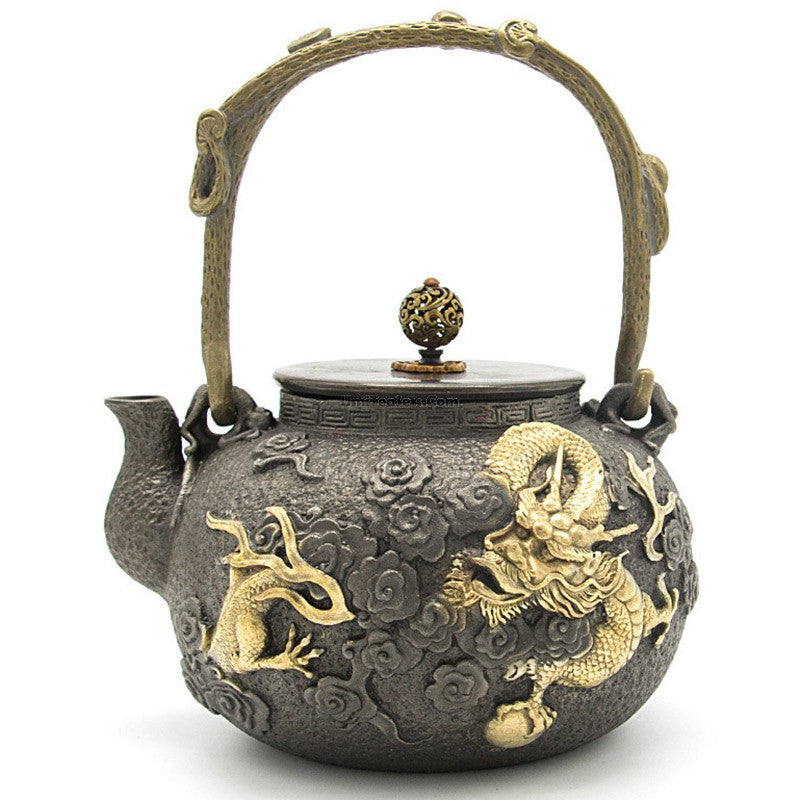 Vendor:Japanese Cast Iron Golden Dragon TeapotUmi Tea Sets
Vendor:Japanese Cast Iron Golden Dragon TeapotUmi Tea Sets- Regular price
-
$139.98 USD - Regular price
-
$167.98 USD - Sale price
-
$139.98 USD
Quick view
-
Japanese Stone Texture Cast Iron Teapot
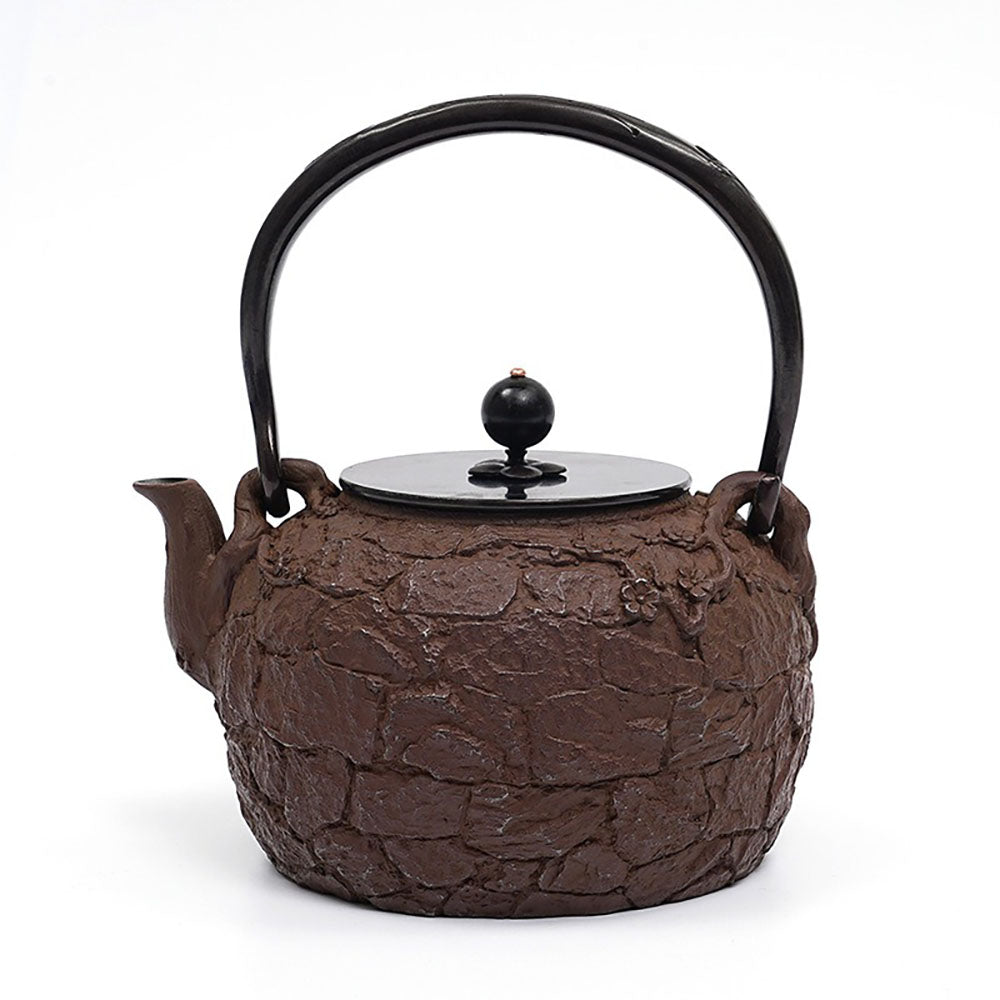 Vendor:Japanese Stone Texture Cast Iron TeapotUmi Tea Sets
Vendor:Japanese Stone Texture Cast Iron TeapotUmi Tea Sets- Regular price
-
$159.98 USD - Regular price
-
- Sale price
-
$159.98 USD
Quick view
-
Japanese Melon Cast Iron Teapot
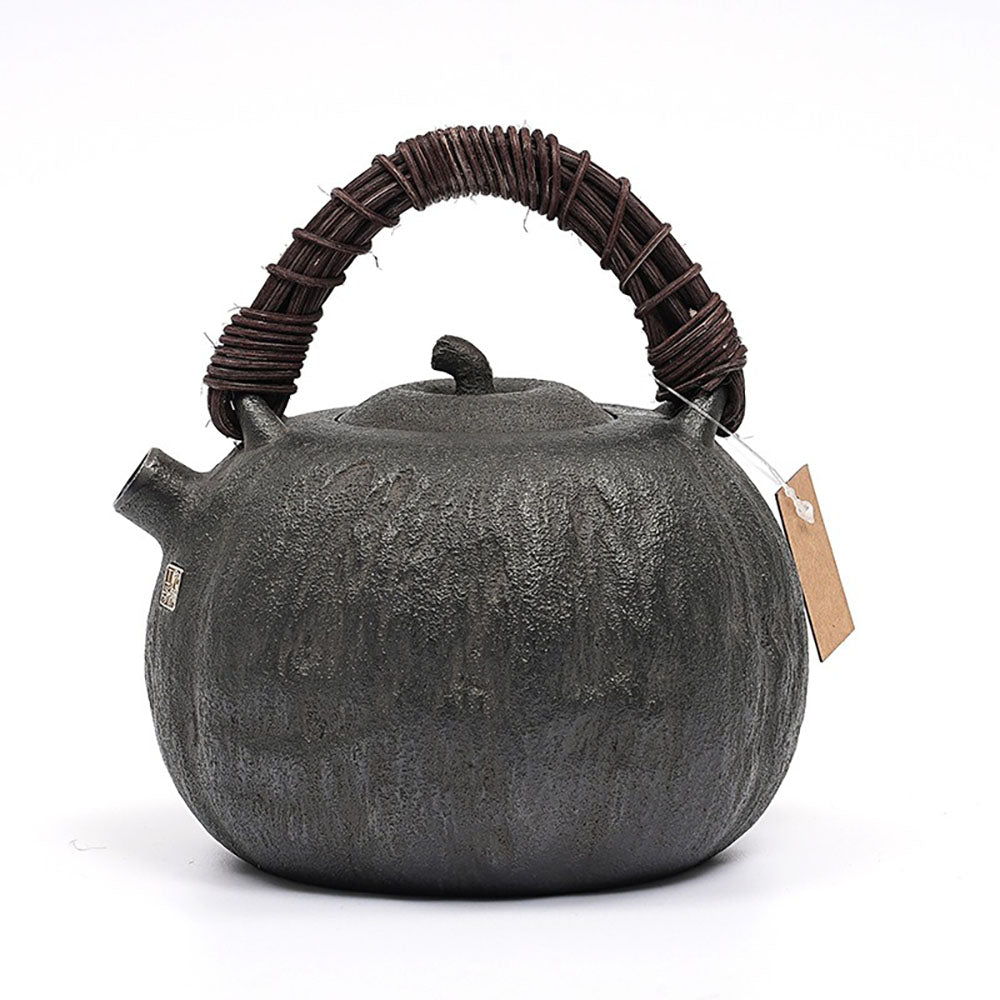 Vendor:Japanese Melon Cast Iron TeapotUmi Tea Sets
Vendor:Japanese Melon Cast Iron TeapotUmi Tea Sets- Regular price
-
$186.98 USD - Regular price
-
- Sale price
-
$186.98 USD
Quick view
-
Japanese Tetsubin Cast Iron Teapot
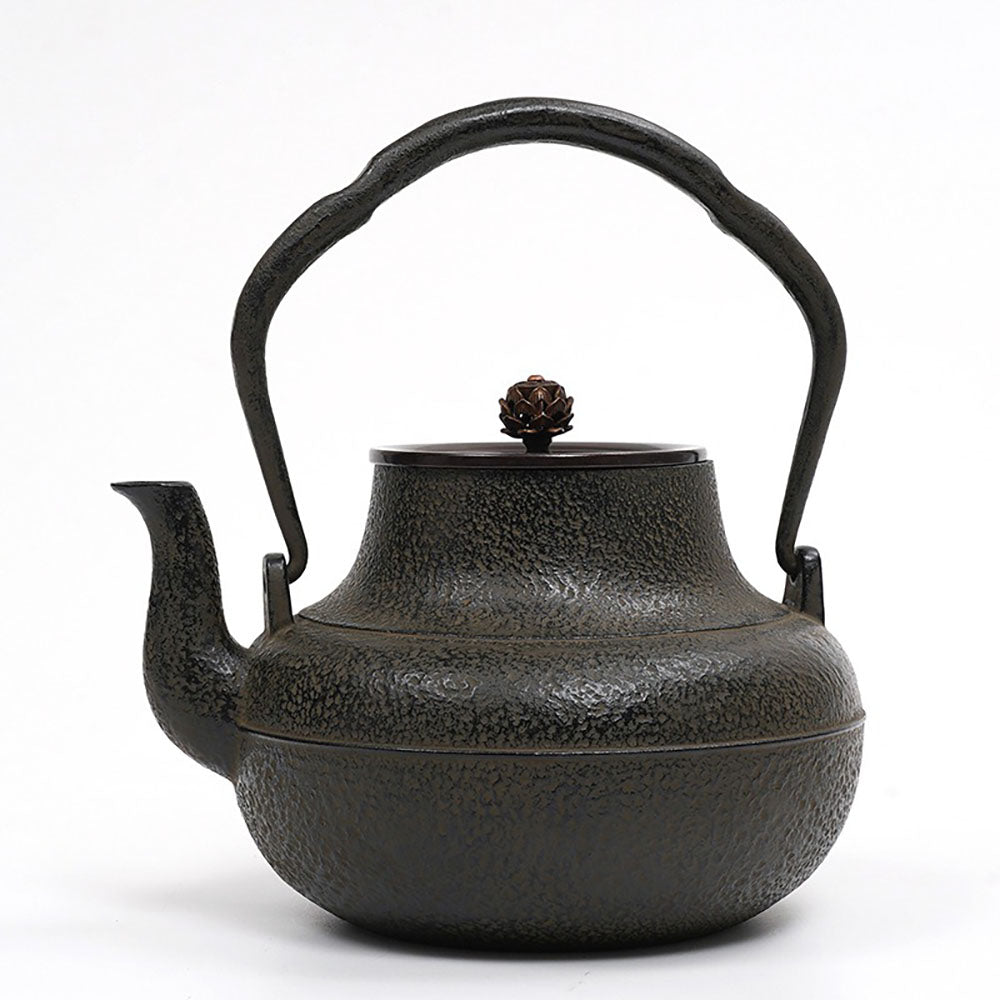 Vendor:Japanese Tetsubin Cast Iron TeapotUmi Tea Sets
Vendor:Japanese Tetsubin Cast Iron TeapotUmi Tea Sets- Regular price
-
$129.98 USD - Regular price
-
- Sale price
-
$129.98 USD
Quick view
-
Japanese Magpie And Blossom Cast Iron Teapot
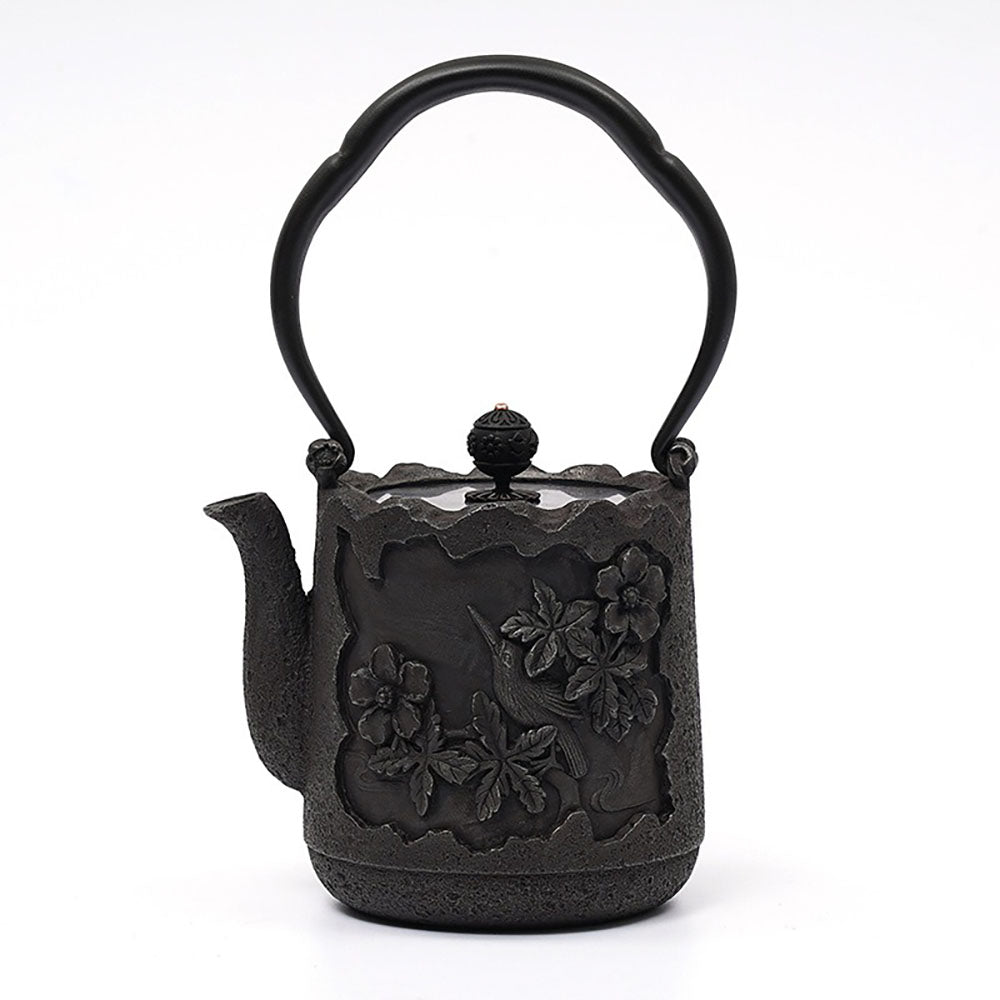 Vendor:Japanese Magpie And Blossom Cast Iron TeapotUmi Tea Sets
Vendor:Japanese Magpie And Blossom Cast Iron TeapotUmi Tea Sets- Regular price
-
$139.98 USD - Regular price
-
- Sale price
-
$139.98 USD
Quick view
-
Japanese Bamboo Weaving Cast Iron Teapot
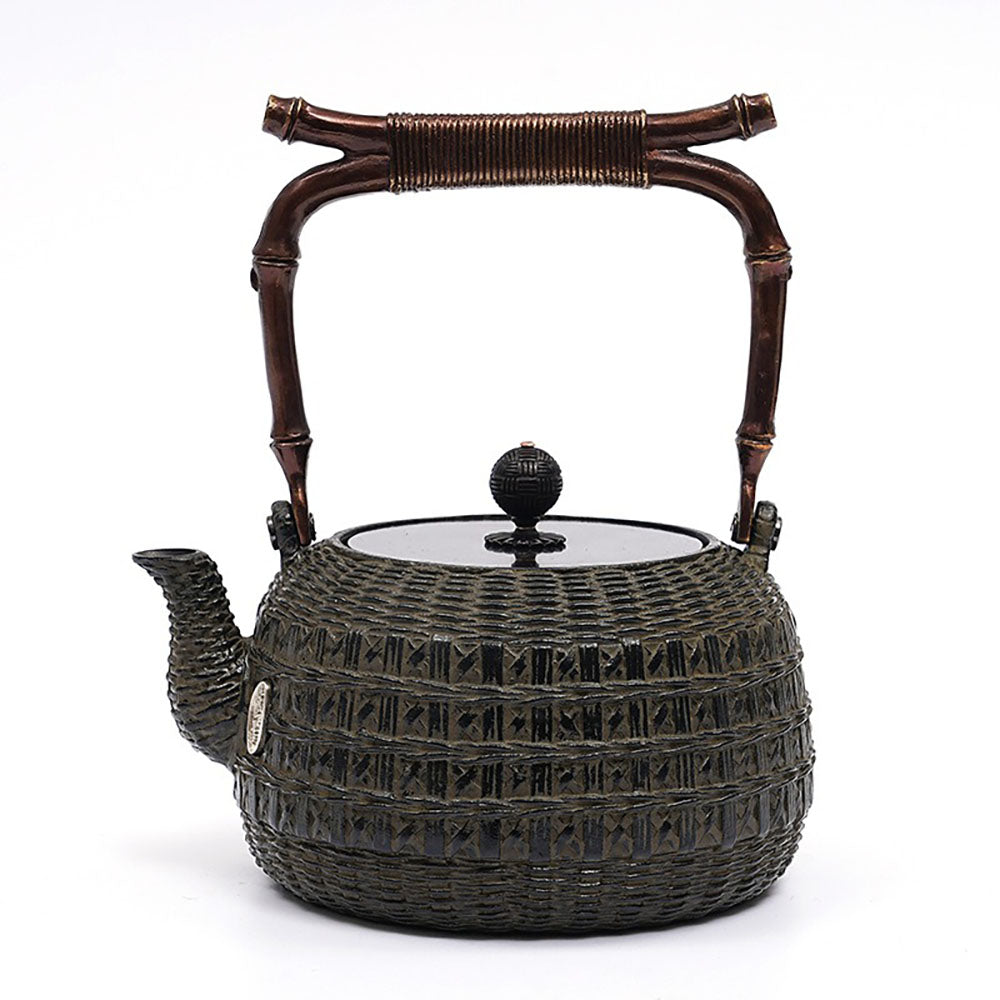 Vendor:Japanese Bamboo Weaving Cast Iron TeapotUmi Tea Sets
Vendor:Japanese Bamboo Weaving Cast Iron TeapotUmi Tea Sets- Regular price
-
$149.98 USD - Regular price
-
- Sale price
-
$149.98 USD
Quick view
-
Japanese Tiger Roar Cast Iron Teapot
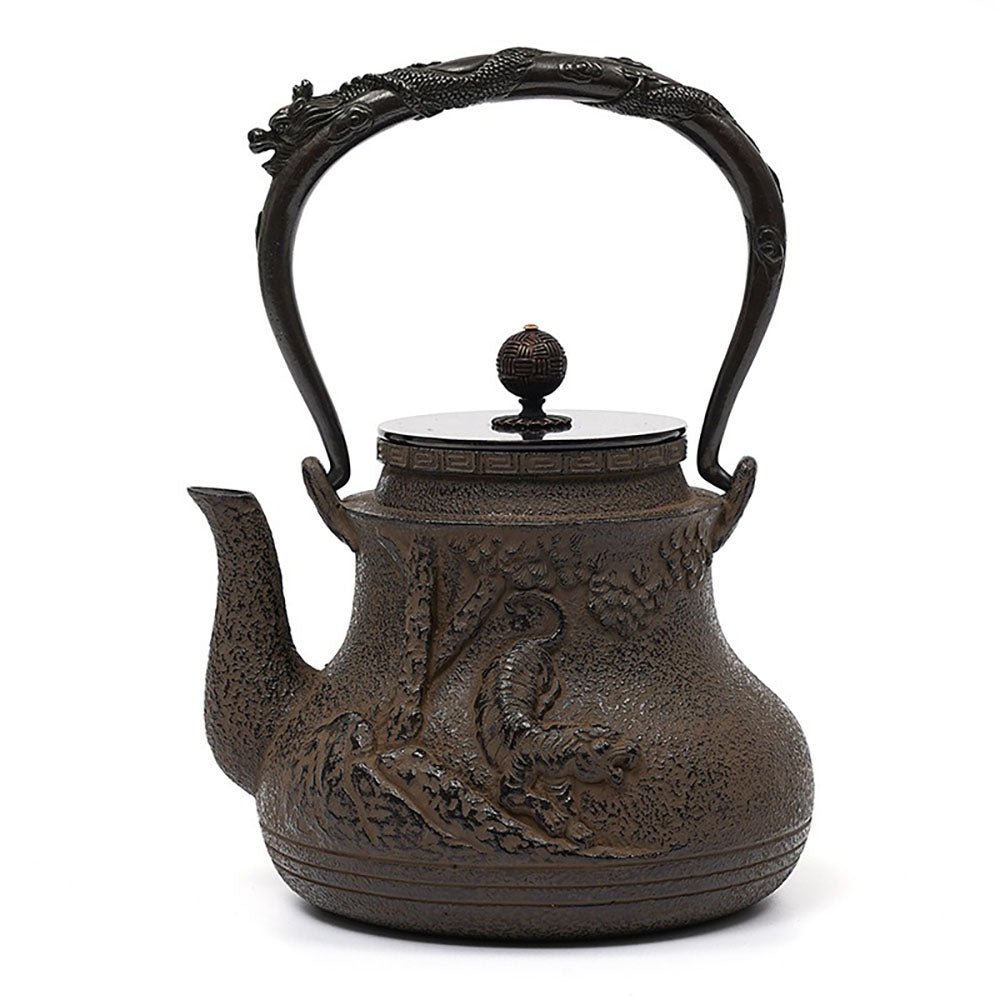 Vendor:Japanese Tiger Roar Cast Iron TeapotUmi Tea Sets
Vendor:Japanese Tiger Roar Cast Iron TeapotUmi Tea Sets- Regular price
-
$129.98 USD - Regular price
-
- Sale price
-
$129.98 USD
Quick view
-
Japanese Dragon Handle Cast Iron Teapot
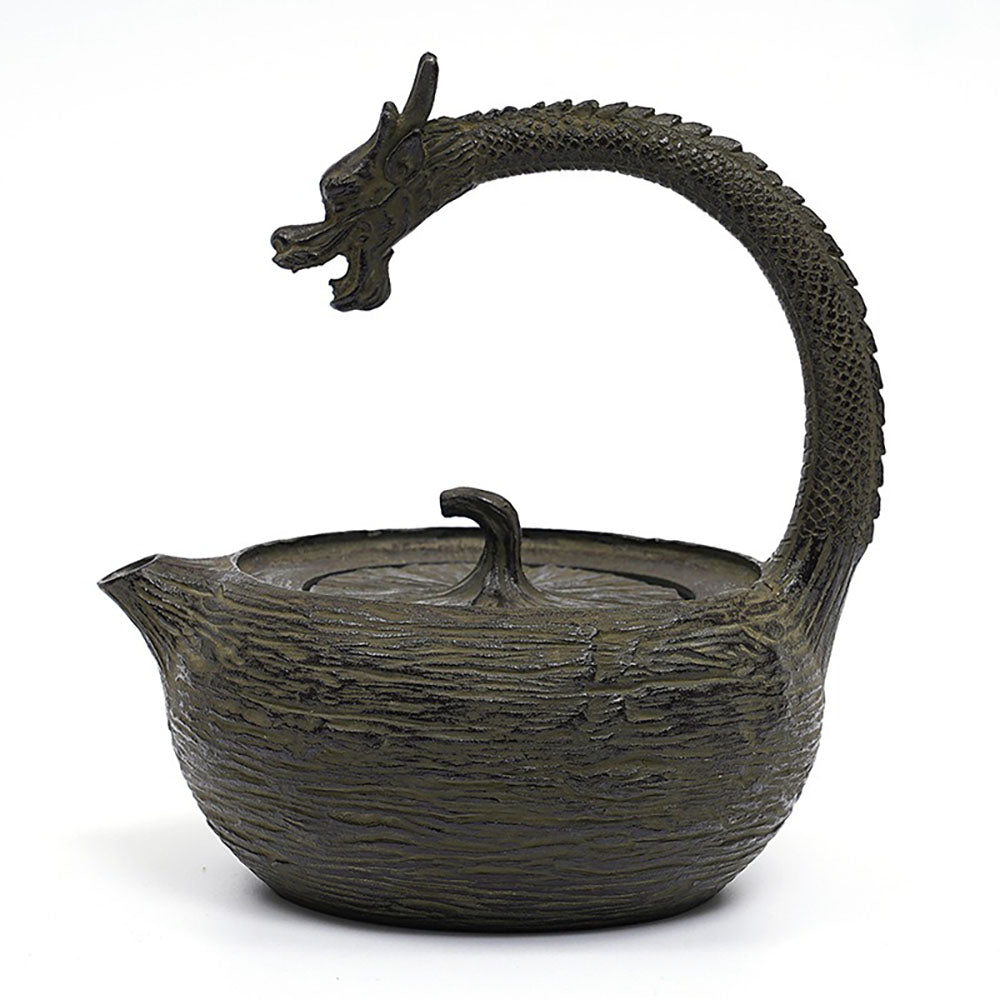 Vendor:Japanese Dragon Handle Cast Iron TeapotUmi Tea Sets
Vendor:Japanese Dragon Handle Cast Iron TeapotUmi Tea Sets- Regular price
-
$119.98 USD - Regular price
-
- Sale price
-
$119.98 USD
Quick view
-
Japanese Sand Iron Side Handle Teapot
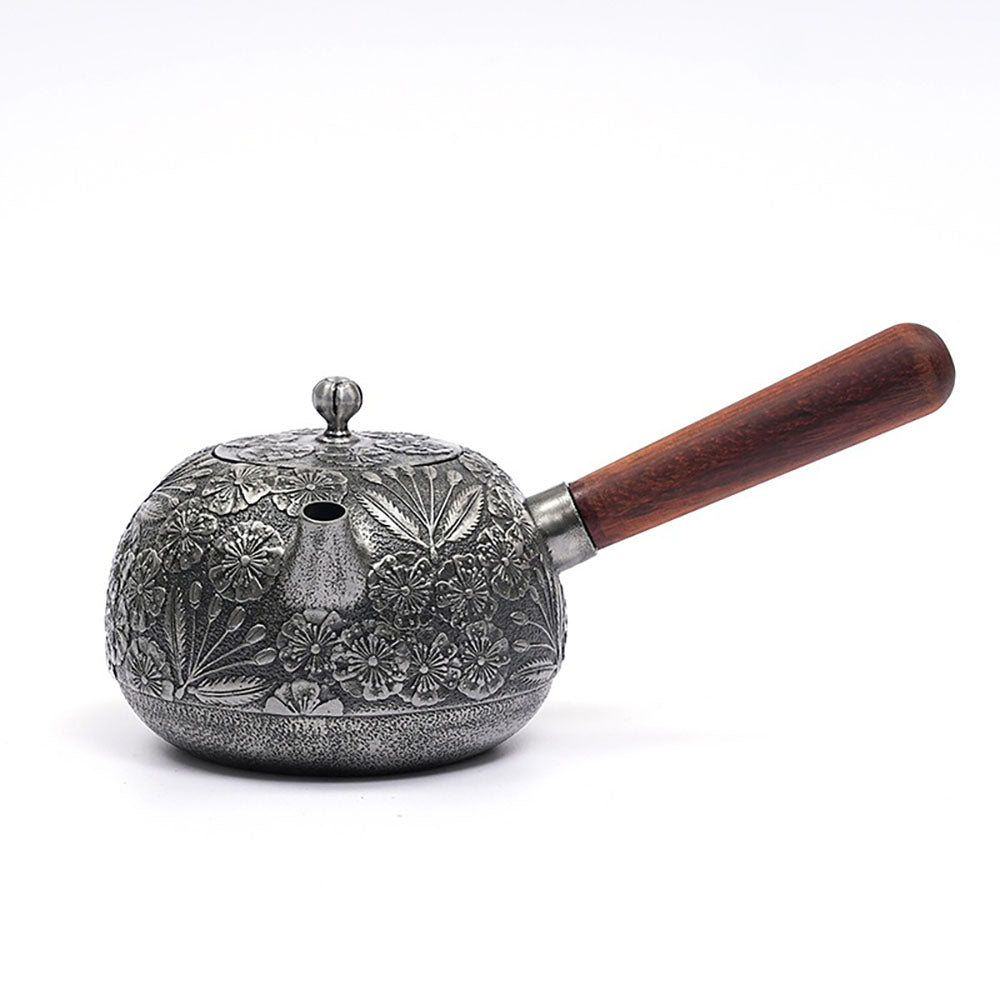 Vendor:Japanese Sand Iron Side Handle TeapotUmi Tea Sets
Vendor:Japanese Sand Iron Side Handle TeapotUmi Tea Sets- Regular price
-
$159.98 USD - Regular price
-
- Sale price
-
$159.98 USD
Quick view
-
Double Dragon Playing Fireball Cast Iron Teapot
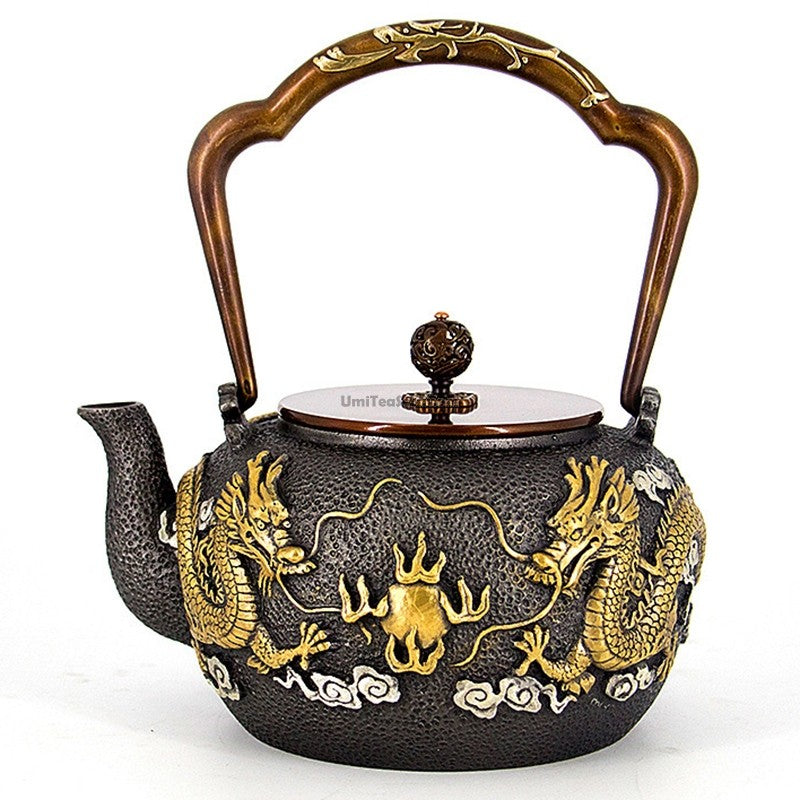 Vendor:Double Dragon Playing Fireball Cast Iron TeapotUmi Tea Sets
Vendor:Double Dragon Playing Fireball Cast Iron TeapotUmi Tea Sets- Regular price
-
$185.98 USD - Regular price
-
$223.18 USD - Sale price
-
$185.98 USD
Quick view
-
Cast Iron Peony Flower Teapot
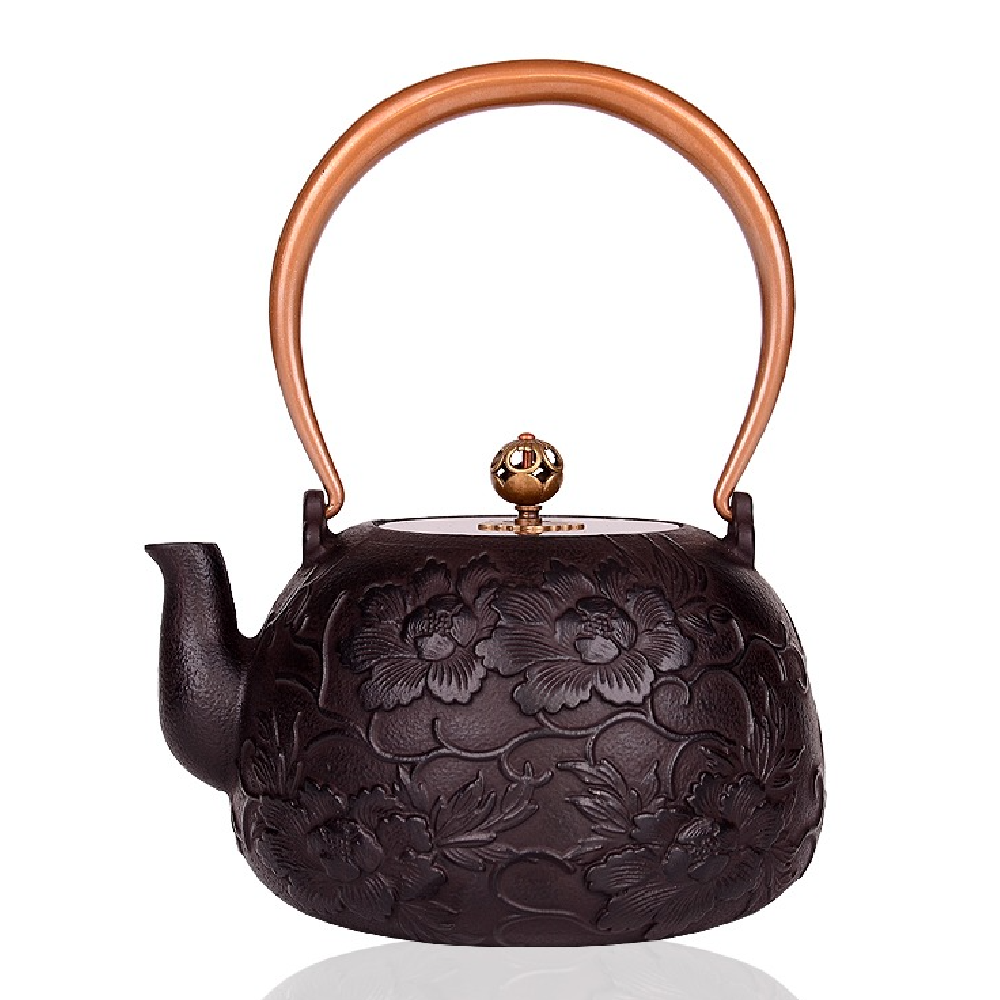 Vendor:Cast Iron Peony Flower TeapotUmi Tea Sets
Vendor:Cast Iron Peony Flower TeapotUmi Tea Sets- Regular price
-
$96.98 USD - Regular price
-
$116.38 USD - Sale price
-
$96.98 USD
Quick view
-
Japanese Pumpkin Cast Iron Teapot
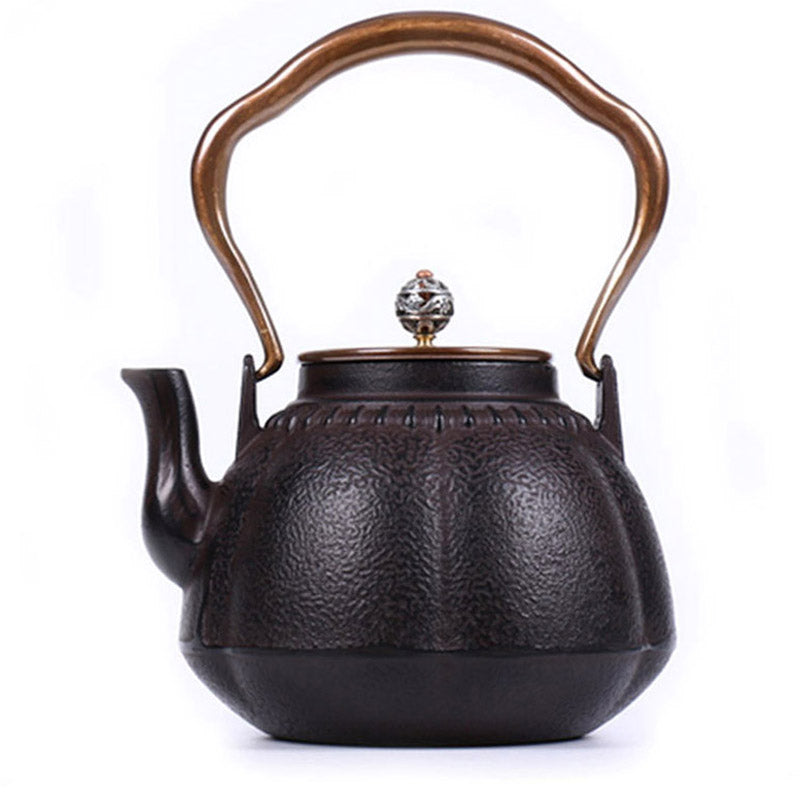 Vendor:Japanese Pumpkin Cast Iron TeapotUmi Tea Sets
Vendor:Japanese Pumpkin Cast Iron TeapotUmi Tea Sets- Regular price
-
$102.98 USD - Regular price
-
$123.58 USD - Sale price
-
$102.98 USD
Quick view
Cast Iron Teapot Production
When cast iron teapots are mentioned, we tend to think of Nambu ironware or Nambu tetsubin. Nambu ironware originated in Japan during the Edo period (1615-1868) in the region under the control of the Nambu Han, i.e., the area centered around Morioka. Nambu ironware developed from tea kettle production. Ironware produced in a number of other areas is also called Nambu ironware, including that of Mizusawa and today's Iwate prefecture. At the Taiwan International Tea Culture Expo held in late-2010 in Taipei, the Mizusawa Casting Industry Cooperative, led by chairmen Oikawa Takashi, exhibited Nambu ironware to great acclaim.
Iwate prefecture is rich in iron ore and other raw materials used in the production of ironware and also produces significant quantities of paint, charcoal, and clay. The area benefitted from the protection of the Nambu Han. All of these factors provided this area with a fertile environment for development of ironware production, and to this day it is still known for Nambu ironware.
Previous articles on this subject focused on the growth of Nambu ironware and on introducing master casters. We hope these articles have helped fellow teapot lovers develop an understanding of the heritage and culture of these cast iron pots. This article is intended to help readers further understand the difficulty involved in producing fine ironware. Although we have not personally produced any ironware, we will attempt to introduce tetsubin production from the materials we have collected.
Production Process
In general, cast iron teapot production applies the following procedure: (1) Design and composition; (2) Wooden mold production; (3) Spout and lid production; (4) Casting mold, production; (5) Casting and pouring; (6) Removal and sand stripping; and (7) Coloring and handle application.
(1) Design and Composition
The first step in cast iron pot production is to determine the shape and decorative features of the pot. In general, it is first necessary to consider whether traditional forms and designs will be used or whether to produce an original creation. All of the following must be considered: the overall design, the size of the mouth, the shape of the spout, the design of the lid, the shape and appearance of the knob, and the colors of the pot. After determining all of these features, the design is drawn on paper maintaining the correct size proportions.
(2) Wooden Mold Production
After the composition sketch is produced, a cross-section is made and used to produce the wooden mold that serves as a casting mold. The molds require approximately three sections: the upper half of the pot body, the lower half of the pot body, and the lid. The wooden molds are so named because they were originally made from wood; however, today they are commonly created from 1.5 mm sheet cast iron. Because teapots are hollow, the core must be produced during the casting of the cast iron pots. Consequently, the mold of the core is produced along with the mold. To ensure a specific thickness of the cast iron pot, the mold of the core is slightly smaller than that of the outer shell.
(3) Pot Spout and Lid Production
These objects refer to attached portions of the cast iron pot other than the body of the pot. They include the spout, knob, and rings connecting the handle to the body of the pot. An additional casting mold must be produced for each of these components. There are a number of possibilities for the shape of the knob on top of the lid, including a plum flower, chrysanthemum, gourd, or precious stone. Some casters may introduce their own creations such as a horse, cow, or butterfly. For the rings, appropriate forms are chosen based on differences in the cast iron pots and may include distant mountains or devilish faces. After turn scraping is completed, the casting mold is created. This turn scraping process is referred to as "pulling the mold" in Japan. During this initial turn scraping process, the pot spout, rings, and other objects are placed in their corresponding positions. Then, using relatively fine sand mixed with clay, turn scraping is again performed. A fine sand that resembles raw silk is then used to make the final adjustments to the mold.
After turn scraping is completed, but the sand mold is not yet completely dry, it is necessary to begin applying the design. The traditional Nambu ironware -- a rare (hailstone) design -- requires use of a metal engraving tool. Workers carefully imprint the designs, one by one. Approximately 2000 markings must be made for a single cast iron pot. For other patterns, the initial sketch of the design may be attached to the sand mold before the patterns are engraved.
The core is also produced at this time. Core production is done in a similar fashion to the casting mold. The wood mold of the core is turn scraped to produce the sand mold. Casters generally divide the above and below sections into two casting molds. After the sand molds are produced, the inside is filled with sand and clay liquid is used to connect the upper and bottom halves. After drying in the sun, the core is removed. Finally, after the casting mold has dried, it is roasted in a charcoal fire to complete the production of the casting mold.
(5) Casting and Pouring
After the casting mold is completed, the upper and lower halves are joined together and the core is placed in the middle. In the casting mold, the base of the cast iron pot is pointed upward, and the overall state of the mold is inverted. Likewise, the base of the core points upward. Two or three small iron sheets or other metal pieces are placed between the bottom of the core and the casting mold to prevent it from floating around during pouring. After the mold is put together, the kiln is heated to 1400-1500 degrees Celsius to melt the iron before pouring it into the mold.
(6) Removal and Sand Stripping
After pouring is completed and the mold has cooled, the casting mold can be broken apart to remove the finished product. Sand stripping can then be performed, which basically involves using a metal pick to break up the core and other attached pieces. Bits of iron may jut out in the areas connecting the upper and lower casting molds. These are removed by gently tapping the pot or by using a grinding tool.
Next the formed cast iron pot is placed in an 800 to 1000 degree charcoal kiln to roast. This step is intended to cause the cast iron pot to form an acidized skin membrane, which can prevent rust. This technique is said to have been invented by the famous Nambu caster Arisaka Goemon. Direct contact with the charcoal flame may cause the exterior of the pot to blacken. If so, a brush is used to clean it.
(7) Coloring and Handle Application
The caster checks whether the kettle leaks. If not, color can be applied. The iron kettle is placed in a 200 degree oven, then paint and thick tea liquor are applied as coloring. Regarding the pot handle, some are handmade and require the work of another craftsman. Often the handle is produced by pounding a piece of sheet iron to form round strips. Once the handle is created and applied to the iron kettle, the production process is complete.
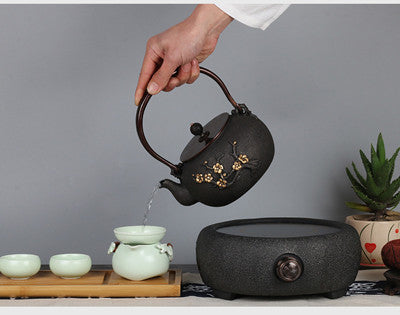
The Language of Iron Tea Kettles
As described above, the production process for handmade iron tea kettles is extremely detailed. It involves more than 60 individual steps. Each detail must be executed with the utmost care and leaves no room for error. At least two months are required to go from the initial sketch to the completed piece. The path to becoming a professional caster takes many years. Becoming a kamu master whose name is engraved on the cast iron pots is clearly even more difficult. Without the accumulation of experience and hard work, it is difficult to achieve acclaim. This type of traditional production method differs from large-scale mechanical production. The skill of the caster is evident in each step of the production process. Each trace left behind by the production process reveals its purpose.
It is worth mentioning, however, that handmade iron kettles created using traditional techniques often contain minor defects. For example, there are often small casting defects where the core and pot meet. Consequently, a Japanese phrase has been passed down in casting workshops that roughly translates to "six intact." The meaning is, even if a complete iron kettle has six defects, it cannot be considered a failure. It can still be used after these defects are fixed. From this, we can see that a flawless tea pot without the slightest defect is not easy to produce. It requires the highest level of care at each step.
From the production procedure, we can also clearly understand the basic characteristics of handmade tea pots. Each workshop has its own production techniques, however, and casters each pursue their own casting methods, which prevents us from speaking in broad generalities. For pots produced using the methods described above, though, we should be able to vaguely make out the marks left where the upper and lower casting molds meet. On the bottom of the pot, we should see where the iron was poured as well as the marks left behind by the iron or other metal pieces used to keep the core in place.
Each cast iron pot expresses its language through different means, telling the story of the techniques and craft of the caster. Through careful observation and appreciation of this language, you should be able to find the pot that speaks to you.

Introduction of Cast Iron Teapots
Use of Japanese cast iron teapots (tetsubin) to brew tea has become extremely fashionable among Taiwanese tea drinkers over the past several years. Tetsubin can now be seen at many tea tasting events and tea ceremony exhibitions. These teapots have become an indispensable part of modern Taiwanese tea culture where it is widely believed that the use of these time-honored pots to brew tea improves both the color and flavor of the tea. Regardless of whether this is true or false, the antique quality that results over time from the combination of texture and pattern design with the rust in a well-cared-for tetsubin is truly captivating.
How exactly, though, does one care for these cast iron tea pots? This is a question that is likely on the mind of many fellow tea drinkers. Previous articles have described tetsubin development and history as well as the close correlation between tetsubin and the Japanese tea kettle (kama). Because they are so similar, tetsubin and kama are essentially cared for in the same way. The Japanese tea ceremony specifies a set of techniques used to care for kama that are, consequently, worthy of our reference.
This product is hand-made and uses the material of pig iron, based on ancient technology and customs. Following the time of Emperor Li Zhizhi's rule, this kind of teapot became a specialty. In order to protect this technique, cast iron teapots have been seen as a handicraft since then. The handcrafted teapot boasts its traditional iron-making technique and its unique Japanese-style of creation, judging from its surface and appearance, and is thus valued by people in Japan.
Cast Iron Teapots are the highest rated of all the iron products. Though their production is based on traditional methods, new techniques have also been adopted to change with the times. It is not only a practical item but also an art form. Fine workmanship is pleasing to the eye and lasts the test of time.
Nearly all tea lovers know that mountain spring or well water is sweeter, so they always try to use these two kinds of water to brew tea. Mountain spring or well water contains more iron elements, and these iron elements exist as Fe2+ when excluded from the air. Water boiled in the pot will taste like spring water because of Fe2+. Generally, this product can enhance the taste of water and is suitable for brewing all kinds of tea.
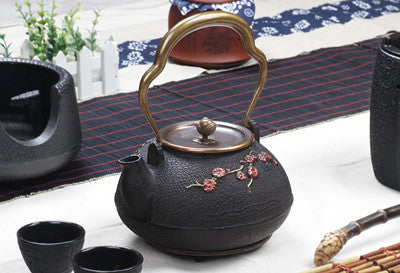
Benefits of Cast Iron Teapots for the Human Body
Scientists have found that iron is helpful for generating more blood, and a male adult needs 0.8-0.5 milligrams of iron. Iron deficiency will hinder the development of one's intelligence. Experiments have proven that using an iron pot to boil water can be helpful to the absorption of iron (Fe2+), preventing anemia. Japanese love using iron utensils to cook food or boil water. In recent years, facts have proven that pots made of pure iron will replenish hemoglobin in children. Also, in the Longevity Village in Japan, most people still use iron pots. According to similar studies, most people who use cast iron teapots do not have low iron or suffer from anemia. Humans cannot directly absorb iron, but when digested in food as Fe3+, gastric acid turns Fe3+ to soluble Fe2+ by chemical reaction.
Usage of Cast Iron Teapots
Many writings in Japan mention that, before using a new iron kettle, one should first place a small number of tea leaves wrapped in cloth in the kettle and boil it for approximately ten minutes. The tannins in the tea and the iron content dissolved from the teapot help to form a tannic iron membrane on the sides of the kettle, which can prevent the formation of rust within the kettle. New kettles should be used daily to allow rapid accumulation of sediment; however, after use one must take care to ensure that the kettle is completely dry after use. Red rust spots generally begin to appear on the interior of the teapot after approximately five days. After approximately ten days, white sediment appears. Each pot is different, however, and the formation of sedimentation varies. After many years of use, the entire interior of some kettles turns red. This is not considered a problem as long as the boiled water remains clear, so if you find such a pot please do not remove it or believe that if there is rust it must be wiped away or washed clean.
During normal use, no water should be left in the pot after using it to brew tea. After heating water and brewing tea, the hot water should be poured out and the interior of the pot should be kept dry. After the tetsubin is entirely cooled, its lid should be left off. If the pot is immediately covered, the steam remaining within will form as water on the interior surface as the temperature falls and promote formation of rust. The lid can be wiped clean with a cloth. In general, if a tetsubin is used daily, the lid can be placed back on the pot after letting it dry overnight. If the tetsubin is not regularly used, it should be set aside for approximately three days before placing it back in the storage box. In addition, do not wipe the inside with a cloth or brush and do not wash it with soap or detergent.
If using an old tetsubin, the interior may at first contain rust or rust spots. It should be treated as described above: that is, first boil tea leaves in the pot.
Next, boil plain water in the pot several times until the water heated in the teapot is clear, at which point the pot is ready to be used.
1. When first using a cast iron teapot, you need to put 5-10 grams of tea in the infuser, pour some water in the pot and boil the water for about 10 minutes. Tannins contained in the tea and the iron element dissolved will form a layer of iron tannate on the inner wall of the pot, which prevents rust from developing. Discard the boiled water and repeat this procedure for about 2-3 times, until the water is clear. It is better to use a new pot everyday so as to let the rust stain form as early as possible.
2. Cast iron teapots are better used over a fire, but gas stoves or hot plates also work.
3. When using a cast iron teapot, fill it with 80% water in case of overflow in boiling. After five days’ use, the inner wall may have some scarlet dots, and ten days after, a white coating may appear. These phenomenons are very common and the water is still safe to drink unless it is muddy.
4. After using the cast iron teapot, remember to fully dry the interior and wipe it clean with a soft cloth. By drying the pot completely after each use, you will prevent any rust from developing, extending the life of your teapot.
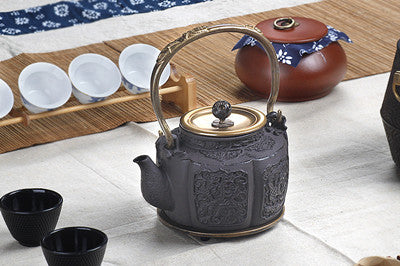
Tetsubin and Rust
Japanese teapots and tea kettles are generally made of cast iron. Aluminum was used to produce teapots during wartime, but today most tetsubin are still primarily made with iron. Because tetsubin and kama are directly placed over a flame to boil water, they may be more easily damaged than other types of tea ware. Among the tea kama collected and housed at major Japanese museums, some were produced prior to the Edo period (1603-1867). Many of the pots have been repaired or restored after a long service life. Although the history of tetsubin is not as long as that of kama, most hundred-year-old and older tetsubin have experienced some sort of damage. Clearly both tetsubin and kama are prone to damage. The most significant cause of such damage is likely rust.
Early kama and tetsubin were primarily produced using an iron ore known as satestu ("iron sand"). However, following the Meiji period (1868-1911), availability of satestu was increasingly limited, and many foundries turned to using relatively affordable iron ore exported from the Western countries. It is difficult to distinguish between teapots produced using the two types of raw materials based on outward appearance; however, it is widely believed that tea kettles produced using traditional satestu materials are more resistant to the formation of rust. All of these pots are made of iron, though, and will eventually oxidize and form rust. However, if a teapot is well cared for, the rust on its surface can provide it with a simple beauty and an indescribable style. To achieve this result, it is essential to pay attention to teapot care.
Maintenance of Cast Iron Teapots
The simplest method for daily maintenance of a tetsubin is to apply lukewarm water all over the exterior after use and set it on the counter to dry naturally. In traditional tea ceremony training, when water reaches boiling in a tea kettle, a piece of lukewarm wet cloth is sometimes used to gently pat or wipe the kettle surface. However, according to some directions to the contrary, the wet cloth may sometimes damage the kettle patterns and decoration. So I simply recommend splashing some lukewarm water onto the surface. Moreover, some producers of Nambu Ironware describe how to maintain the exterior of tetsubin in their user manuals. Specifically, when the kettle is still somewhat warm, a piece of cloth wet with tea water can be used to gently wipe the exterior. Such repetitive wiping may leave unique hues on the body of the teapot. Yet, as the tea water easily reacts with the tetsubin, such maintenance should be done as evenly as possible ways to avoid differences in color.
During tea ceremony training, the instructor repetitively warns us not to touch the tea kettles with our hands. This is due to the fact that our hands may contain some oil, and touching the kettle may leave residue or introduce dust. Consequently, we use tongs whenever we handle the kettles. This warning is also applicable to handling of tetsubin. In the end, the touch may lead to rust or hue change, or affect the beauty of the patterns and ornamentation of the teapot. We should note that many people, when maintaining their tetsubin, apply a layer of plant oil or other fats to preserve the beauty of the tetsubin. The approach to oil application is useful in brightening the surface with unique eye-catching charm. However, by doing so, the surface of the tetsubin may become damaged, absorb dust, and thus become rusted. Sometimes, when a tetsubin is heated, fat penetration into the interior may result in water pollution. Therefore, I would not advise you to adopt this method of maintenance.
One more reminder is that, upon use of a tetsubin, no detergent or brush should be used for cleaning the interior walls. Excessive application of such cleaning materials may destroy the interior layer of the teapot wall originally treated to be resistant against rust. Generally the interior of the pot just needs to be soaked and flushed with pure water. However, if it is an old tetsubin, with severe rust inside the teapot, some oil may float on the surface and the water may turn to a reddish color when boiled. To address such problems, theoretically, we should invite a tetsubin specialist to retreat the interior of the teapot to make it resistant to rust. But in Taiwan, it would be very difficult to find such specialists. According to some Japanese collectors, certain brushes can be used to remove the internal rust. Afterward, brewing tea several times followed by boiling pure water is necessary to form a rust-resistant membrane inside. This method is worth considering.
1. The temperature of the teapot and the water within must not be extremely different. If you pour hot water in the pot when the pot's body is cold or pour cool water in the pot when the pot's body is warm, the pot may face the danger of fissure. It is better if you have two cast iron teapots ready for use. But if you only have one pot, you can add hot water to replenish the pot.
2. Keep the cast iron teapot dry. After use, if there is water left, the pot is prone to rust. So do remember to fully evaporate the water by the water after each use.
3. Avoid heating an empty pot. Heating a dry pot will reduce the life of the teapot and may cause fissure of the pot.
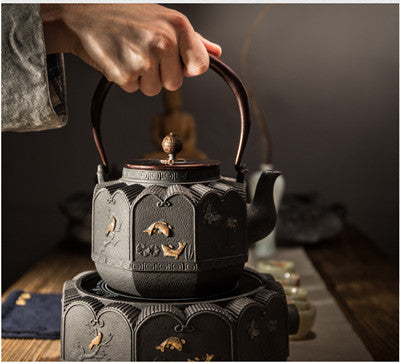
Tetsubin and Water Sediment
The instructions above can be considered general knowledge on the use of tetsubin. Fellow drinkers may still ask such questions as: after several years of use, why is there no water sediment built up inside? I conducted a number of experiments during travel to Japan using a variety of water sources selected for boiling in the tetsubin. Not until about a week of experiments did I witness the formation of some sedimentation from a certain kind of water.
The problem lies in determining what type of water is conducive to formation of sediment. One thing is certain: no formation of sediment was seen when using tap water for the experiments. The only water able to build up sediment, according to my findings, turned out to be drinking water from a well, or groundwater. Unfortunately, analysis of water quality was not available for the experiments.
It is also interesting to learn that, during the experiments, there were no rust stains produced inside the tetsubin. Instead, at the beginning some substance similar to white silk formed inside and after around one week, a thin layer of water sediment covered the interior surface. Depending on differences in the origin of the tetsubin or the craftsman, the effects also vary. For the experiment, I used tetsubin from Zuiun of Kyoto, a chagama from Arisaka of Morioka, and a tetsubin from the Kichiemon family. A layer of white water sediment formed inside the Zuiun, whereas the tetsubin from Kichiemon had no similar reaction.
Perhaps some people would argue that boiling water in a pot with water sedimentation is harmful to one's health. In general, formation of the water sediment is good for the tetsubin in terms of its role in preventing rust and producing sweeter water quality. Therefore, both for tea aroma and tetsubin maintenance, it is necessary to carefully select a certain kind of water for use in the tetsubin.
In closing, it is our hope that the introduction above will serve as a reference for fellow tea drinkers in how to care for their tetsubin, and that all readers will brew increasingly satisfying tea as time goes by thanks to the integration of texture, design, and unique hue of rust in their tetsubin.












